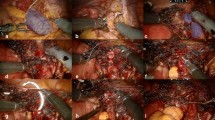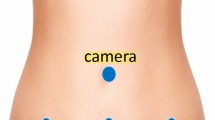Abstract
Purpose
As a serious type of deep infiltrating endometriosis (DIE), ureteral endometriosis (UE) can result in decreased kidney function. The aims of this study are to investigate risk factors and surgical treatments for UE.
Methods
The study enrolled 329 patients with deep infiltrating endometriosis, who were treated with laparoscopic surgery between January 2014 to September 2018. All patients were divided into one of two groups: UE or non-UE. Clinical information and other surgery variables of the two groups were examined.
Result
Out of 329 patients with DIE, 68 (20.67%) cases of UE were diagnosed. Among them, 37 patients also had hydroureteronephrosis. In a multivariate analysis, the variables revised American Fertility Society (rAFS) stage IV, uterosacral ligament (USL) DIE lesion ≥ 3 cm in diameter and previous surgery for endometriosis significantly increased the risk of UE. A total of 27.03% (10/37) of patients with UE and hydroureteronephrosis showed decreased kidney function. Ureterolysis was performed in 59 patients, and an ureteroneocystostomy was performed in 9 patients. A double-J stent was placed in 37 patients with UE. Only 1 patient developed acute pyelonephritis postoperatively. During more than 2 years of follow-up, no patient experienced recurrence.
Conclusions
The variables of rAFS stage IV, USL DIE lesion ≥ 3 cm in diameter and previous surgery for endometriosis significantly increased the risk of UE. Laparoscopic ureterolysis and ureteroneocystostomy are feasible and safe procedures with low complication and recurrence rates.
Similar content being viewed by others
References
Vercellini P, Vigano P, Somigliana E, Fedele L (2014) Endometriosis: pathogenesis and treatment. Nat Rev Endocrinol 10(5):261–275. https://doi.org/10.1038/nrendo.2013.255
Cornillie FJ, Oosterlynck DJ, Lauweryns JM, Koninckx PR (1990) Deeply infiltrating pelvic endometriosis: histology and clinical significance. Fertil Steril 53(6):978–983. https://doi.org/10.1016/S0015-0282(16)53570-5
Koninckx PR, Martin DC (1992) Deep endometriosis: a consequence of infiltration or retraction or possibly adenomyosis externa? Fertil Steril 58(5):924–928. https://doi.org/10.1016/S0015-0282(16)55436-3
Lee HJ, Lee YS (2017) Deep infiltrating ureteral endometriosis with catamenial hydroureteronephrosis: a case report. J Med Case Rep 11(1):346. https://doi.org/10.1186/s13256-017-1518-6
Campagnacci R, Perretta S, Guerrieri M, Paganini AM, De Sanctis A, Ciavattini A, Lezoche E (2005) Laparoscopic colorectal resection for endometriosis. Surg Endosc Other Interv Tech 19(5):662–664. https://doi.org/10.1007/s00464-004-8710-7
Ruffo G, Scopelliti F, Manzoni A et al (2014) Long-term outcome after laparoscopic bowel resections for deep infiltrating endometriosis: a single-center experience after 900 cases. BioMed Res Int 2014:463058. https://doi.org/10.1155/2014/463058
Comiter CV (2002) Endometriosis of the urinary tract. Urol Clin N Am 29(3):625–635. https://doi.org/10.1016/S0094-0143(02)00065-4
Berlanda N, Vercellini P, Carmignani L, Aimi G, Amicarelli F, Fedele L (2009) Ureteral and vesical endometriosis. Two different clinical entities sharing the same pathogenesis. Obstet Gynecol Surv 64(12):830–842. https://doi.org/10.1097/OGX.0b013e3181c4bc3a
Antonelli A, Simeone C, Zani D, Sacconi T, Minini G, Canossi E, Cunico SC (2006) Clinical aspects and surgical treatment of urinary tract endometriosis: our experience with 31 cases. Eur Urol 49(6):1093–1098. https://doi.org/10.1016/j.eururo.2006.03.037
Abrao MS, Dias JA, Bellelis P, Podgaec S, Bautzer CR, Gromatsky C (2009) Endometriosis of the ureter and bladder are not associated diseases. Fertil Steril 91(5):1662–1667. https://doi.org/10.1016/j.fertnstert.2008.02.143
Frego E, Antonelli A, Tralce L, Micheli E, Cunico SC (2002) Ureteral endometriosis: urological features. Arch Ital Urol Androl 74(1):3–5
Patel A, Thorpe P, Ramsay JW et al (1992) Endometriosis of the ureter BJUI 69(5):495–498. https://doi.org/10.1111/j.1464-410X.1992.tb15595.x
Bosev D, Nicoll LM, Bhagan L, Lemyre M, Payne CK, Gill H, Nezhat C (2009) Laparoscopic management of ureteral endometriosis: the Stanford University Hospital experience with 96 consecutive cases. J Urol 182(6):2748–2752. https://doi.org/10.1016/j.juro.2009.08.019
Yohannes P (2003) Ureteral endometriosis. J Urol 170(1):20–25. https://doi.org/10.1097/01.ju.0000054836.32660.9e
Chapron C, Chiodo I, Leconte M, Amsellemouazana D, Chopin N, Borghese B, Dousset B (2010) Severe ureteral endometriosis: the intrinsic type is not so rare after complete surgical exeresis of deep endometriotic lesions. Fertil Steril 93(7):2115–2120. https://doi.org/10.1016/j.fertnstert.2009.01.102
Shook TE, Nyberg LM (1988) Endometriosis of the urinary tract. Urology 31(1):1–6. https://doi.org/10.1016/0090-4295(88)90560-2
Seracchioli R, Mabrouk M, Manuzzi L et al (2008) Importance of retroperitoneal ureteric evaluation in cases of deep infiltrating endometriosis. J Minim Invasive Gynecol 15(4):435–439. https://doi.org/10.1016/j.jmig.2008.03.005
Leonhartsberger N, Zelger B, Rehder P (2008) Intrinsic endometriosis of ureter and bladder in young women without gynecological symptoms. Urol Int 80(2):222–224. https://doi.org/10.1159/000112619
Alves J, Puga M, Fernandes R, Pinton A, Miranda I, Kovoor E, Wattiez A (2017) Laparoscopic management of ureteral endometriosis and hydronephrosis associated with endometriosis. J Minim Invasive Gynecol 24(3):466–472. https://doi.org/10.1016/j.jmig.2016.11.018
Andrews WC, Buttram VC, Behrman SJ et al (1985) Revised American Fertility Society classification of endometriosis: 1985. Fertil Steril 43(3):351–352
Knabben LM, Imboden S, Fellmann B, Nirgianakis K, Kuhn A, Mueller MD (2015) Urinary tract endometriosis in patients with deep infiltrating endometriosis: prevalence, symptoms, management, and proposal for a new clinical classification. Fertil Steril 103(1):147–152. https://doi.org/10.1016/j.fertnstert.2014.09.028
Cavacogomes J, Martinho M, Gilabertaguilar J, Gilabertestelles J (2017) Laparoscopic management of ureteral endometriosis: a systematic review. Eur J Obstet Gynecol Reprod Biol 210:94–101. https://doi.org/10.1016/j.ejogrb.2016.12.011
Huang J, Guo H, Li J, Chen S (2017) Management of ureteral endometriosis with hydronephrosis: Experience from a tertiary medical center. J Obstet Gynaecol Res 43(10):1555–1562. https://doi.org/10.1111/jog.13422
Stepniewska A, Grosso G, Molon A et al (2011) Ureteral endometriosis: clinical and radiological follow-up after laparoscopic ureterocystoneostomy. Hum Reprod 26(1):112–116. https://doi.org/10.1093/humrep/deq293
Husby GK, Haugen RS, Moen MH (2003) Diagnostic delay in women with pain and endometriosis. Acta Obstet Gynecol Scand 82(7):649–653. https://doi.org/10.1034/j.1600-0412.2003.00168.x
Hadfield RM, Mardon HJ, Barlow DH, Kennedy S (1996) Delay in the diagnosis of endometriosis: a survey of women from the USA and the UK. Hum Reprod 11(4):878–880. https://doi.org/10.1093/oxfordjournals.humrep.a019270
Kondo W, Branco AW, Trippia CH, Ribeiro R, Zomer MT (2013) Retrocervical deep infiltrating endometriotic lesions larger than thirty millimeters are associated with an increased rate of ureteral involvement. J Minim Invasive Gynecol 20(1):100–103. https://doi.org/10.1016/j.jmig.2012.09.012
Kinkel K, Chapron C, Balleyguier C, Fritel X, Dubuisson J, Moreau J (1999) Magnetic resonance imaging characteristics of deep endometriosis. Hum Reprod 14(4):1080–1086. https://doi.org/10.1093/humrep/14.4.1080
Bazot M, Lafont C, Rouzier R, Roseau G, Thomassinnaggara I, Darai E (2009) Diagnostic accuracy of physical examination, transvaginal sonography, rectal endoscopic sonography, and magnetic resonance imaging to diagnose deep infiltrating endometriosis. Fertil Steril 92(6):1825–1833. https://doi.org/10.1016/j.fertnstert.2008.09.005
Chamie L, Blasbalg R, Goncalves MO, Carvalho FM, Abrao MS, De Oliveira IR (2009) Accuracy of magnetic resonance imaging for diagnosis and preoperative assessment of deeply infiltrating endometriosis. Int J Gynecol Obstet 106(3):198–201. https://doi.org/10.1016/j.ijgo.2009.04.013
Rozsnyai F, Roman H, Resch B et al (2011) Outcomes of surgical management of deep infiltrating endometriosis of the ureter and urinary bladder. J Soc Laparoendosc Surg 15(4):439–447. https://doi.org/10.4293/108680811X13176785203798
Maccagnano C, Pellucchi F, Rocchini L et al (2013) Ureteral endometriosis: proposal for a diagnostic and therapeutic algorithm with a review of the literature. Urol Int 91(1):1–9. https://doi.org/10.1159/000345140
Uccella S, Cromi A, Casarin J, Bogani G, Pinelli C, Serati M, Ghezzi F (2014) Laparoscopy for ureteral endometriosis: surgical details, long-term follow-up, and fertility outcomes. Fertil Steril 102(1):160–166. https://doi.org/10.1016/j.fertnstert.2014.03.055
Buttice S, Lagana AS, Mucciardi G et al (2016) Different patterns of pelvic ureteral endometriosis What is the best treatment? Results of a retrospective analysis. Arch Ital Urol Androl 88(4):266–269. https://doi.org/10.4081/aiua.2016.4.266
Seracchioli R, Mabrouk M, Montanari G, Manuzzi L, Concetti S, Venturoli S (2010) Conservative laparoscopic management of urinary tract endometriosis (UTE): surgical outcome and long-term follow-up. Fertil Steril 94(3):856–861. https://doi.org/10.1016/j.fertnstert.2009.04.019
Saavalainen L, Heikinheimo O, Tiitinen A, Harkki P (2016) Deep infiltrating endometriosis affecting the urinary tract-surgical treatment and fertility outcomes in 2004–2013. Gynecol Surg 13(4):435–444. https://doi.org/10.1007/s10397-016-0958-0
Yucel C, Ulker V, Kisa E, Koc G, Ilbey YO (2018) Laparoscopic transperitoneal nephrectomy in non-functioning severe hydronephrotic kidneys with or without renal stone. Cureus 10(12):e3729. https://doi.org/10.7759/cureus.3729
Gulpinar MT, Akcay M, Sancak EB et al (2015) Comparison of transperitoneal laparoscopic nephrectomy outcomes in atrophic and hydronephrotic kidneys. Turk J Urol 41(4):181–184. https://doi.org/10.5152/tud.2015.97523
Author information
Authors and Affiliations
Contributions
ZJH: protocol development, data collection and management, data analysis, manuscript writing, responsible surgeon. PQL: protocol development, data collection and management, data analysis, manuscript writing, responsible surgeon. QL: data collection, data analysis, responsible surgeon. HZ: data collection, data analysis, responsible surgeon, YXS: data collection, responsible surgeon, XXZ: data collection, responsible surgeon, LX: data collection, responsible surgeon, KJL: protocol development, data management, data analysis, manuscript editing, responsible surgeon.
Corresponding author
Ethics declarations
Conflict of interest
The authors declare that they have no conflicts of interest.
Additional information
Publisher's Note
Springer Nature remains neutral with regard to jurisdictional claims in published maps and institutional affiliations.
Rights and permissions
About this article
Cite this article
Hu, Z., Li, P., Liu, Q. et al. Ureteral endometriosis in patients with deep infiltrating endometriosis: characteristics and management from a single-center retrospective study. Arch Gynecol Obstet 300, 967–973 (2019). https://doi.org/10.1007/s00404-019-05268-9
Received:
Accepted:
Published:
Issue Date:
DOI: https://doi.org/10.1007/s00404-019-05268-9




